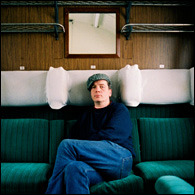

|
| home | movie reviews | features | sov horror | about | forum |
Q&A with Tomas Alfredson (Let the Right One In)
Director Tomas Alfredson is little known outside of his native Sweden, where he has been directing movies and television programs for well over a decade. This year marks his foray into horror movies, with the quiet, chilling, and surprisingly sweet Let the Right One In. The film has earned plenty of notice in the U.S. and the inevitable Hollywood remake is scheduled for 2010 with Cloverfield director Matt Reeves at the helm. Prior to the North American release of Let the Right One In, Alfredson sat down with the press to talk about it. Question: What governed the decision to set the film in the 1980s? Why not set it in the present? Tomas Alfredson: Because it's autobiographical... except for the vampire stuff, of course. John Ajvide Lindqvist, the author of the book and the screenplay, was twelve or thirteen back then and we wanted to preserve that. Q: How closely did you work with Lindqvist on the adaptation? TA: Well, it's a fairly long book. It's about 360 pages, and contains a lot of subplots. For example, Eli's blood supplier, Håkan [Per Ragner] is an outspoken pedophile in the book, which I couldn't handle properly onscreen. It would be too large, too complicated to bring to this story. We had to pick one track to go with, and that was the love story. Q: Did you stick to script with the shooting, or were the kids allowed to ad-lib? TA: We didn't really have the space to do that. The shooting was so complicated and there were a number of special effects, though not all of them were obvious. So it was a very tight schedule and it didn't allow for very much ad-libbing. But there was one sequence, involving some of the bullies, that involved something unplanned. One of the actors playing the tormentors had been bullied himself. There's a scene in the film when they're hitting Oskar over his legs. One of the boys starts crying in the midst of it. That was a surprise: it wasn't planned that way. He got very emotional over the scene because of his own experiences. We kept it in because it was very strong and we felt it added a lot of nuance to the situation. Q: What drew you to the project? TA: I think it was the story of the bullied boy: the very unsentimental attack on this complicated young person. I had some times when I was a kid like that, being bullied. That was the thing that struck me the hardest. The producer brought the script to me, and I normally don't think you should do films of good books. You have so much more time and space to tell a story in a book than in a film. It's seldom that you see a good book turning into a good movie. Somehow, this felt like one of those exceptions, and I fell in love with it. Q: The look of the film is very striking. Did you have an aesthetic model for it? TA: Winter hits very hard in Sweden, of course. It's like you push a "pause" button on everything. Everything stops and all life becomes artificial. Artificially heated, artificially powered, and outside it's all motionless. Also, after any heavy snowfall, there is a very special kind of silence. You can hear your own heartbeat, your own breathing, even your own eyelids moving. I wanted to capture that emotion. As far as specific influences, I actually don't think I had seen any vampire films at all before I made this. Maybe a few on television when I was a kid. Bela Lugosi and the like. But the photographer and I studied Renaissance painters very closely. When it comes to lighting, to colors, and to characters -- that very strange sort of eye contact that Renaissance paintings have -- those works were very helpful. There is one painter in particular named Hans Holbein, who did some really creepy work. Music too. I was listening to Mahler and similar dark, Romantic music to inspire me: to help find the lighter elements in this dark story. Q: How did you find the two leads? TA: It was very long process; it took us nearly a year. We don't have professional child actors in Sweden, so we had to have open castings. That was very tough. I always thought of these two children as the same character: two sides of the same character. So it wasn't just finding the right boy and the right girl, but matching them up to the same character, with her as the dark side and he as the light. Q: What are the challenges of shooting in Sweden in the winter? There's weather conditions, but in that part of the world, there's also lighting conditions. What did you find the most difficult? TA: It's very tough to capture "cold" on film. If the temperatures go up even by one or two degrees, you won't see it. So you must shoot in very extreme temperatures, which we had. It was about minus 30 degrees Celsius. I don't know what that is in Fahrenheit [about 22 below 0], but it was very, very cold. The cameras were stopping all the time, and I got frostbite in two of my fingers. At the same time, it's very beautiful and very crisp, and it has a strange kind of poetry to it. The light is so white, it's like knives. And there wasn't much daylight, which was helpful. We did this in the very north of Sweden to get the cold and the snow, and up there in January or February, you only get one or two hours a day of light. That let us get night shooting done almost anytime, which made scheduling much easier. Q: The sound is very meticulous here, very technical. Did you pick that up naturally, or did you have to dub it in later? TA: The sound process was very complicated because visually, it's very important to have a dialogue with the audience. Most entertainment today is monologues coming out of the screen at you. A lot of films are overloaded with too much sound and effects and images. But if you leave out things or deliberately omit things visually, you always keep the audience interested. You make visual suggestions to the audience that help engage them. The same is true with sound. If you choose to have a lot of silence in your movie, it will really draw attention to the things you do hear. For instance, if you have a shot of a big city with a lot of cars and people, and all you hear on the soundtrack is a bird, your eyes will immediately start scanning the screen for the bird. It keeps you very active as an audience member. We did end up dubbing Lina Leandersson, who plays Eli the vampire. She has a very high-pitched voice and I wanted her to be more... what's the English word? Not female... Q: Androgynous? TA: Yes, androgynous. More boyish. So we had another girl with a lower pitch to her voice dubbing the dialogue. Q: You did your own editing on this. When you're planning the film, do you factor that into account as a way of minimizing time and expense? TA: Oh yes. I started out as an editor when I was young, so I can do, say, three shots of a scene and know where the various lines of dialogue go in each shot. That's helpful when you're actually shooting because you know whether you got the shot you need or not. It cuts down on wasted time considerably. Q: You just won the Woodstock award, and the Best Narrative Award at the Tribeca Film Festival. TA: The American audiences I've shown this film to really seem to understand it, and that rarely happens with Swedish films over here. It's very encouraging. Q: What's your take on the enduring popularity of vampire stories? Even after hundreds of years, people still find new things to say with them. TA: These kind of tales, they come and they go. Every twenty years or so, a new cycle starts. I suppose they touch things in our personalities that have to do with the animal inside us. The instinctive side, the side that demands survival at all costs. We may be a little more aware of that in Sweden. Maybe we have suppressed the animal part of ourselves a little more than elsewhere; we don't always notice that side of humanity as much. Article published 10.29.2008. Read Rob Vaux's review of Let the Right One In.
|


|
| home | movie reviews | features | sov horror | about | forum |
| This site was previously at flipsidemovies.com from 2000 to 2008. |
|
contact | copyright | privacy | links | sitemap
Flipside Movie Emporium (FlipsideArchive.com)
|